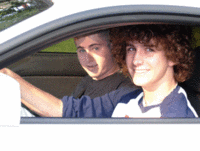Edmunds.com Reveals Top 10 Dangerous Driving Behaviors for Young Drivers
 |
SANTA MONICA, Calif.--Edmunds.com, the premier online resource for automotive information, today reported on potentially life-threatening driving behaviors and offered suggestions for staying focused.
“Young drivers need to be especially careful since their lack of experience makes it harder for them to successfully maneuver out of dangerous situations,” warns Caroline Pardilla, Editor of the Edmunds.com Young Drivers Guide. “During summer vacation, teens will spend more time behind the wheel and need to understand the importance of focusing on the road instead of their cell phone or iPod.”
According to the Insurance Institute for Highway Safety, drivers between the ages of 16 to 19 are four times likelier than older drivers to be involved in car accidents. Car crashes continue to be the leading cause of death among teenagers of driving age.
Edmunds.com’s article “10 Driving Distractions and How To Deal With Them” includes discussion of:
- Cell phone use: Common sense suggests that manipulating a cell phone while driving will increase the likelihood of an accident. However, as presented in “Driven to Distraction: Cell Phones in the Car,” hands-free systems have not been shown to have any positive effect on reducing that rate.
- Loud music: Listening to loud music inhibits the driver’s ability to hear horns and emergency vehicles, and can stimulate faster, more reckless driving.
- Passengers: Passengers can be distracting, especially to young drivers. Studies show that young drivers with young passengers tend to get in more accidents than those driving alone. Many states now address this issue by including passenger restrictions in graduated licensing programs.
- Anger and stress: Some people go for a drive as a means of combating anger or stress, but tense motorists may have impaired judgment and may be more likely to drive in an aggressive manner.
- Text-messaging: For many, text-messaging is becoming a primary means of communication, and some drivers are multi-tasking at great risk.
For a more detailed discussion of these and other risky driving behaviors, please see “10 Driving Distractions and How To Deal With Them” in Edmunds.com’s Young Drivers Guide. Also, read “Multitasking Mania and Distracted Driving” and “Top 10 Editors' Tips to Prevent a Car Accident” for more information on staying safe behind the wheel.


